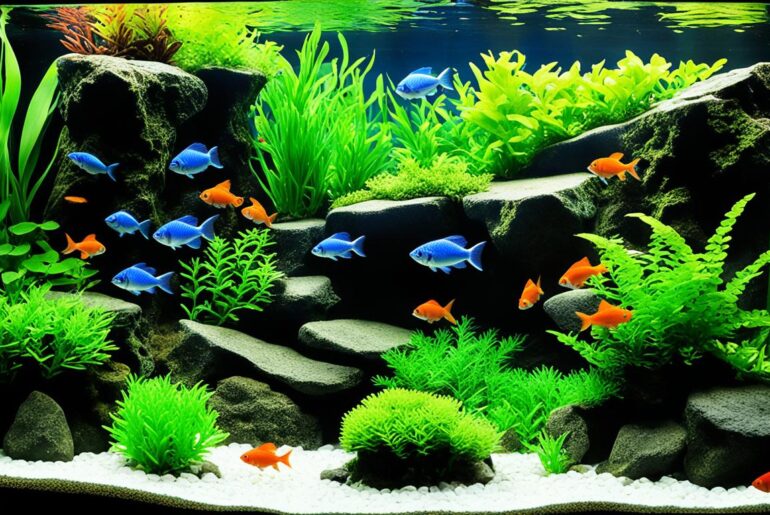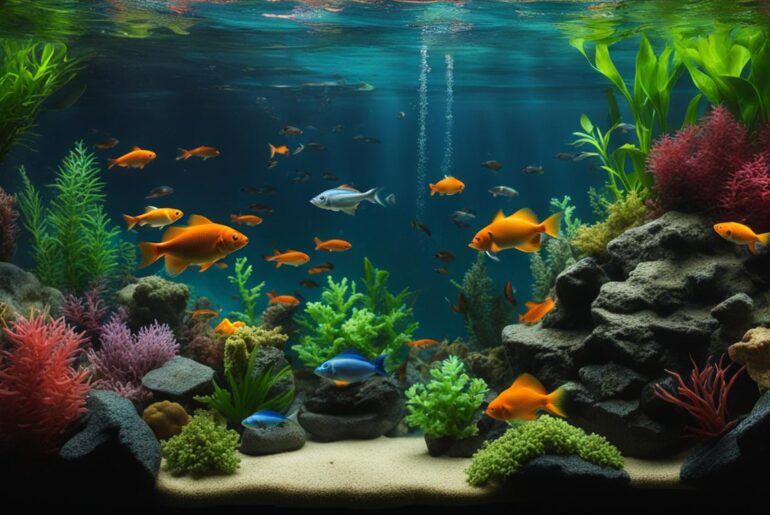When I first set up my freshwater aquarium, I was filled with excitement and anticipation. The vibrant colors of the fish, the gentle bubbling of the filter, and the lush greenery of the plants created a serene and captivating underwater world. However, my joy quickly turned to frustration when I noticed tiny creatures slowly multiplying and taking over my once pristinely balanced tank – snails.
These pesky snails seemed to appear out of thin air, slithering their way across the glass walls and feasting on the delicate leaves of my plants. Not only were they unsightly, but they were also wreaking havoc on the carefully cultivated ecosystem I had worked so hard to establish.
Desperate to regain control of my aquarium, I embarked on a mission to find effective solutions for freshwater aquarium snail control and prevention. Through trial and error, research, and guidance from experts, I discovered a range of tips and methods that proved invaluable in taming the snail population and restoring harmony to my tank.
In this article, I will share my hard-earned knowledge and provide you with 7 tips for freshwater aquarium snail control success. Whether you’re dealing with an existing snail infestation or want to take preventative measures, these strategies will help you maintain a thriving aquarium environment free from the clutches of unwanted snails.
Key Takeaways:
- Snail overpopulation is a common problem in freshwater aquariums.
- Overfeeding your fish can contribute to snail population explosions.
- Chemicals should only be used as a last resort for snail control.
- Snail traps can be effective in catching and removing snails from your tank.
- Introducing snail predators can help keep the snail population in check.
Avoid Overfeeding to Control Snail Population
Overfeeding your aquarium inhabitants can lead to a boom in snail population. To control snail overpopulation, try underfeeding your fish and only providing enough food for them to eat at each feeding. This will reduce the amount of excess food that snails can feed on and help control their numbers.
Feeding your fish the right amount is crucial for maintaining a balanced aquarium ecosystem. When food is left uneaten, it decomposes and releases nutrients into the water, creating an ideal environment for snails to thrive. To prevent overfeeding and subsequent snail infestation, follow these tips:
- Observe the behavior of your fish: Pay attention to how much food they consume within a few minutes. If there is still food left after 2-3 minutes, you are likely overfeeding.
- Feed in smaller portions: Instead of giving your fish a large amount of food in one go, divide their meals into smaller portions throughout the day. This helps prevent overfeeding and ensures that they consume all the food before it reaches the substrate.
- Remove uneaten food promptly: If you notice any food remaining after feeding, remove it immediately to prevent snails from scavenging on it.
- Consider feeding fish species that are less likely to contribute to snail infestations: Some fish, such as fast-swimming species or those with small mouths, are less likely to leave behind excess food. Research the feeding habits of potential tankmates before adding them to your aquarium.
Remember, maintaining a proper feeding schedule is essential for the overall health and well-being of your fish, as well as controlling snail populations. By avoiding overfeeding, you can keep your aquarium in balance and enjoy a snail-free aquatic environment.
Quote:
“Proper feeding practices are key to preventing snail overpopulation in freshwater aquariums. By providing only the necessary amount of food, you can effectively control snail numbers and maintain a healthy ecosystem.” – Aquarist Pro
| Feeding Method | Description | Effectiveness |
|---|---|---|
| Underfeeding | Providing only enough food for fish to consume at each feeding | Highly effective in controlling snail populations |
| Overfeeding | Providing an excessive amount of food, leading to uneaten leftovers | Promotes snail overpopulation due to excess food availability |
| Feeding in smaller portions | Dividing meals into smaller portions throughout the day | Helps prevent overfeeding and reduces snail population growth |
| Timely food removal | Removing uneaten food promptly to prevent snail feeding | Supports snail control by limiting their food source |
Use Chemicals as a Last Resort for Snail Control
When it comes to managing snail populations in your freshwater aquarium, it’s essential to explore natural solutions before resorting to chemicals. While chemicals can be effective in killing snails, they should only be used as a last resort to avoid potential harm to your fish and plants. One commonly used chemical for snail control is copper sulfate, which is fish-safe when used correctly.
However, it’s crucial to carefully follow the directions on the bottle to ensure the proper dosage and application. Excessive use of chemicals can lead to a massive snail die-off, which may cause additional challenges in maintaining water quality and cleanliness. It’s essential to strike a balance between eradicating snails and preserving a healthy ecosystem in your aquarium.
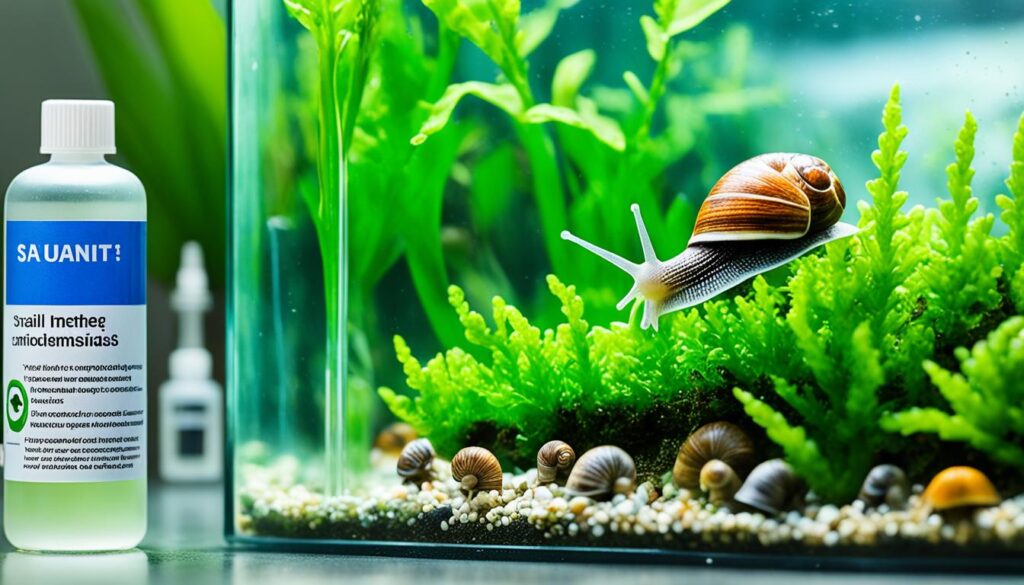
H3: Pros and Cons of Using Chemicals for Snail Control
It’s important to weigh the pros and cons of using chemicals for snail control in your aquarium. Here are some things to consider:
| Pros | Cons |
|---|---|
|
|
As with any method of snail control, it’s important to consider the potential risks and benefits before using chemicals. If you decide to go this route, be sure to follow the instructions carefully and monitor your aquarium closely for any negative effects.
Remember, chemicals should only be used as a last resort when all other methods have been exhausted or proven ineffective. By exploring natural solutions first, you can maintain a healthier and more balanced freshwater aquarium environment.
Set Snail Traps to Catch and Remove Snails
Managing snail infestations in aquariums can be challenging, but setting snail traps is an effective method for controlling their population. There are various snail traps available online and in pet stores, but you can easily create a homemade trap using a large piece of lettuce.
To create your own snail trap, simply place the lettuce in the tank and secure it to the side using a clip or weight. Overnight, the snails will be attracted to the lettuce and gather on its surface. In the morning, you can easily remove the lettuce and the snails that have gathered on it.
By repeating this process for multiple nights, you can significantly reduce the snail population in your aquarium. It’s important to remember that snail traps are most effective for smaller tanks or localized snail infestations.
“Setting snail traps is a simple and effective method for managing snail infestations in aquariums. By providing an enticing food source and removing the trapped snails, you can help control their population and create a more balanced aquatic environment.”
Snail Trap Table
| Snail Trap Type | Description |
|---|---|
| Homemade Lettuce Trap | A homemade trap using a large piece of lettuce secured to the side of the tank. Snails are attracted to the lettuce and can be easily removed in the morning. |
| Commercial Snail Traps | Various commercially available snail traps that are designed to attract and catch snails. These traps often use bait or specific designs to entice the snails. |
| DIY Bottle Trap | A DIY trap made from a plastic bottle with holes cut into the sides. Snails enter the bottle to access bait placed inside and become trapped. |
Using snail traps is a proactive approach to managing snail infestations in freshwater aquariums. By removing snails from the tank, you can help control their population and maintain a healthier aquatic environment. Combine snail traps with other snail control methods for best results.
Introduce Snail Predators to Control Snail Population
One effective and natural way to control snails in freshwater tanks is by introducing snail predators. These predators can help keep the snail population in check, preventing overpopulation and its associated problems. Let’s take a look at some of the common snail predators that can be added to your aquarium:
Zebra or Dwarf Chain Loaches
For smaller tanks, Zebra or Dwarf Chain loaches are excellent options as snail predators. These fish are known for their voracious appetite for snails and can quickly reduce the snail population in your tank. They are also active and playful, adding an interesting dynamic to your aquarium.
Clown Loaches or Pictus Catfish
If you have a larger tank, Clown Loaches or Pictus Catfish can be added as snail predators. These larger predators are highly effective at controlling snail populations and can consume a significant number of snails. However, it’s important to note that they require ample space and appropriate tank mates.
Assassin Snails
Assassin snails are another natural predator that can be introduced to control snail populations. These small and colorful snails are known for their carnivorous diet, as they actively feed on other snails. Assassin snails can be a great addition to your tank as they help keep the snail population in check while adding visual appeal.
By introducing these snail predators to your freshwater tank, you can effectively control snail populations naturally. However, it’s important to choose the predators that are suitable for your tank size and compatible with the existing inhabitants. Always research the specific care requirements and behaviors of the predators before adding them to your aquarium.
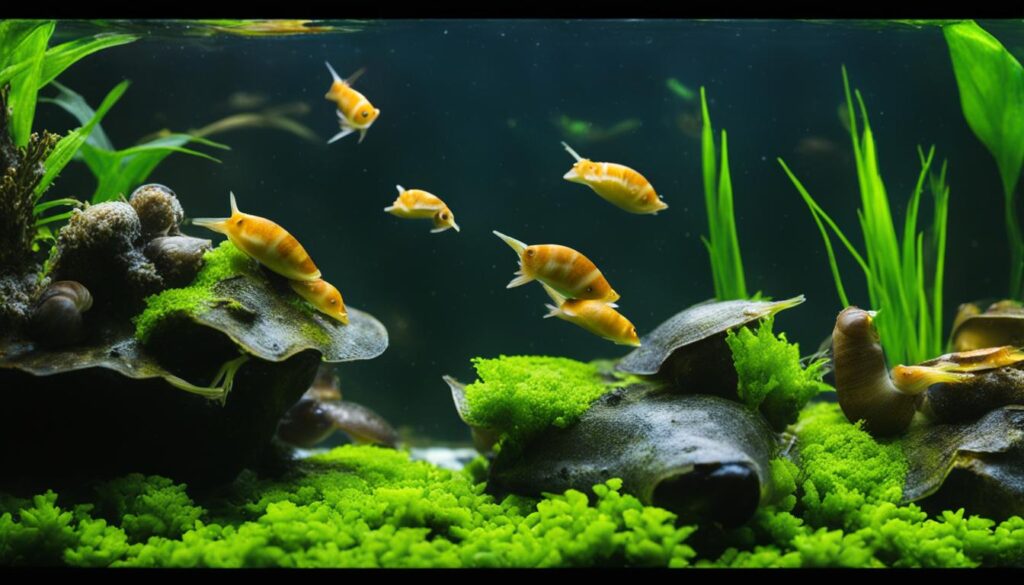
Remember to monitor the impact of the predators on the snail population and adjust accordingly. It’s also essential to provide a balanced diet for the predators and ensure they have a suitable habitat to thrive in. By maintaining a healthy ecosystem with the right balance of snail predators, you can effectively control snail populations in your freshwater tank.
Try Multiple Solutions for Snail Control
When it comes to freshwater aquarium snail control, it’s important to be proactive and try multiple solutions to effectively manage their population. Since snails can quickly multiply and overwhelm the tank, a combination of different methods may be necessary to keep their numbers in check. The DIY approach allows aquarium owners to experiment with various control options and find what works best for their specific situation.
Each type of snail may respond differently to different control measures, so it’s important to be persistent and adaptable in your approach. Trying a range of solutions will help you gauge the effectiveness of each method and identify the most suitable for your fish tank. Here are some DIY snail control solutions you can try:
- Manual Removal: Removing snails manually is one of the simplest and most effective methods to control their population. Use a small net or tweezers to carefully remove visible snails from the tank.
- Snail Traps: You can create homemade snail traps by placing lettuce or cucumber slices into the tank overnight. In the morning, remove the bait along with the collected snails. This method works especially well for larger snails.
- Natural Predators: Introducing snail predators can help keep their population under control. Fish species like Assassin snails, Clown Loaches, and Pictus Catfish are known to feed on snails.
- Chemical Treatments: While chemicals should always be used as a last resort, they can be effective in controlling snail populations. Copper sulfate is a commonly used fish-safe chemical, but it’s important to carefully follow the instructions to avoid harming other aquarium inhabitants.
- Altering Water Conditions: Some snails are sensitive to changes in water conditions. Adjusting the pH, temperature, or hardness of the water can help discourage their growth and reproduction.
Remember that prevention is the key to effective snail control in the long term. Regular tank maintenance, including removing excess food, maintaining proper filtration, and keeping the tank clean, will help prevent snail populations from exploding. Don’t forget to quarantine new tank additions to prevent introducing snails into your aquarium.
By being proactive, persistent, and open to trying different methods, you’ll be able to find the most effective DIY snail control solutions for your fish tank. Happy fishkeeping!
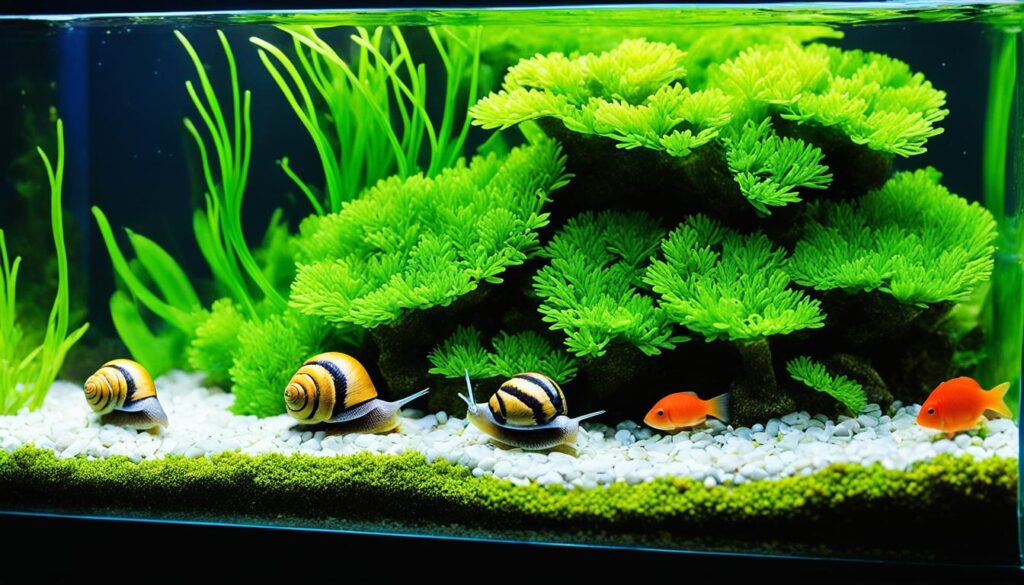
I tried various snail control methods, from manual removal to using snail traps and even introducing natural predators. It took some time and experimentation, but I finally found what works best for my tank. Don’t get discouraged if one method doesn’t work – keep trying different solutions until you find the one that works for you.
Clean Everything to Eliminate Snails
If the snail infestation is severe or you want to completely resolve the issue, a deep clean of the tank may be necessary. This involves removing all items in the tank, including gravel, decor, and plants, and thoroughly cleaning and drying them before refilling and restocking the tank.
Snails can leave behind eggs and microorganisms that can contribute to their rapid reproduction. By cleaning all tank elements, including substrate, decorations, and plants, you can eliminate snails and their eggs, breaking the reproductive cycle and reducing their population.
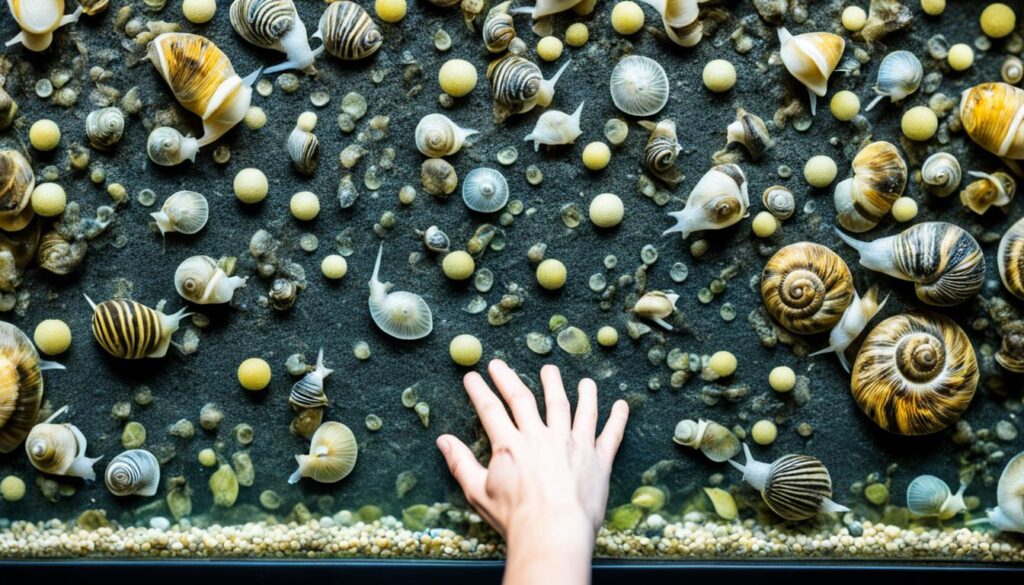
Step-by-Step Guide for Cleaning Your Tank:
- Remove all fish and other inhabitants and place them in a separate container with tank water.
- Carefully remove all gravel or substrate from the tank and rinse it thoroughly under running water to remove any snails, eggs, or debris.
- Scrub and clean the tank walls, decorations, and equipment, making sure to remove any stubborn snail eggs or algae spots.
- Dispose of any heavily infested plants or trim them back and dip them in a snail-killing solution before returning them to the tank.
- Rinse and clean the filter media, ensuring that it is free from snails, eggs, and dirt.
- Allow all tank elements to dry completely before reassembling the aquarium.
- Refill the tank with dechlorinated water, reattach the filter, and return the cleaned substrate, decorations, and plants.
- Acclimate the fish and other inhabitants back into the tank, ensuring the water parameters are suitable for their well-being.
Cleaning the tank thoroughly helps eliminate any remaining snails and prevents their reinfestation. Additionally, maintaining good tank hygiene, such as regular water changes and proper feeding, can further discourage snail populations from thriving.
Inspect and Quarantine New Tank Additions
When it comes to preventing snail infestations in your fish tank, one of the most important steps is to thoroughly inspect any new items before adding them. This includes live plants and decor, which can often harbor snails or their eggs.
Before placing live plants in your aquarium, take the time to carefully examine them. Look for any signs of snails or gelatinous masses that could indicate the presence of snail eggs. If you spot any, remove the snails or eggs manually to prevent them from being introduced into your tank.
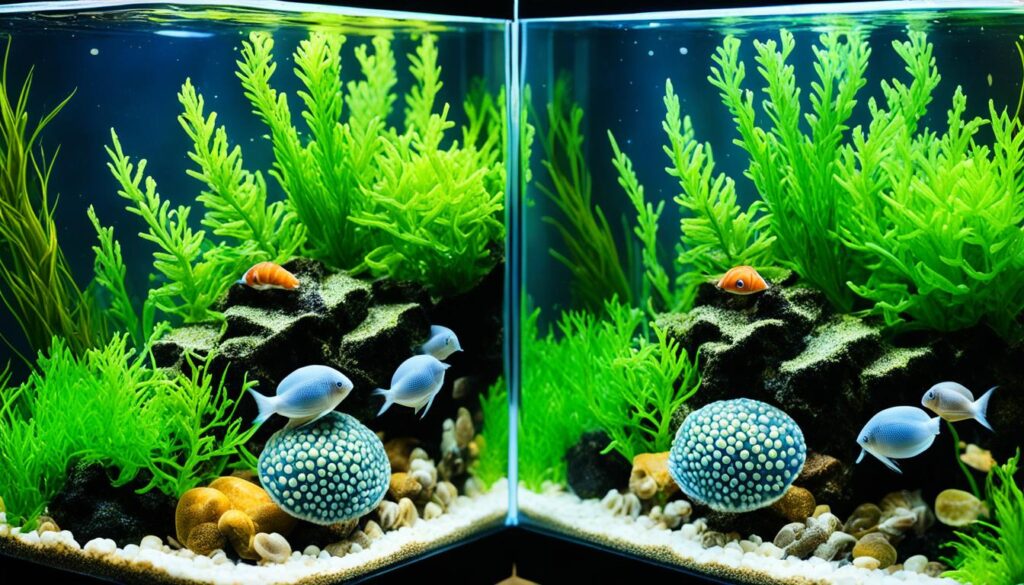
Another effective strategy is to utilize quarantine tanks for new additions. By isolating plants, decor, or new fish in a separate tank, you can closely monitor them for any signs of snail infestation. This allows you to prevent any potential snails or eggs from spreading to your main aquarium, giving you better control over the snail population.
During the quarantine period, thoroughly inspect the quarantined items to ensure there are no snails or eggs present. If you identify any, promptly remove them and continue monitoring until you are confident they are snail-free.
Tip: Remember, prevention is key! Taking the time to inspect and quarantine new tank additions can significantly reduce the risk of introducing snails into your aquarium.
Benefits of Inspecting and Quarantining Tank Additions
Inspecting and quarantining new tank additions offers several advantages:
- Early detection: By inspecting plants, decor, and fish before adding them to your tank, you can identify and remove any snails or eggs early on, preventing them from becoming a full-blown infestation.
- Controlled monitoring: Utilizing a quarantine tank allows you to closely observe new additions and take necessary actions to prevent any potential snail problems from spreading to your main aquarium.
- Preserving tank ecosystem: By preventing snail infestations, you can maintain a balanced and healthy ecosystem for your fish, plants, and other aquarium inhabitants.
Take the necessary precautions to inspect and quarantine new tank additions to keep your fish tank free from unwanted snails and their potential population explosion.
| Benefits of Inspecting and Quarantining Tank Additions: |
|---|
| Early detection |
| Controlled monitoring |
| Preserving tank ecosystem |
Dip Aquarium Additions in a Snail Killing Solution
When dealing with a snail infestation in your aquarium, it’s important to take swift and effective action. One method that can help eliminate snails and their eggs is to dip aquarium additions in a snail killing solution.
Two commonly used snail killing solutions are bleach and aluminum sulfate. However, caution must be exercised when using these chemicals to avoid harming live plants and other aquarium inhabitants. It is crucial to thoroughly rinse the treated items before adding them back into the tank.
Let’s take a closer look at the snail killing solutions:
| Snail Killing Solution | Usage and Precautions |
|---|---|
| Bleach | A solution of 1 part bleach to 19 parts water can be effective in killing snails and their eggs. It is important to soak the items in the bleach solution for 5 minutes before thoroughly rinsing them. Rinse several times to ensure there is no residual bleach left before returning the items to the aquarium. Avoid using bleach on porous materials such as driftwood or certain types of decor, as it can be difficult to remove completely. |
| Aluminum Sulfate | Another option is to use aluminum sulfate, which can be found at garden supply stores. Follow the manufacturer’s instructions for usage and dosage. This chemical is less harmful to live plants and may be a better option if you have a planted tank. |
Using a snail killing solution can be an effective method to eradicate snails from your aquarium. However, be sure to follow all safety precautions and use these solutions as a last resort, after trying other natural and mechanical methods.

Provide Adequate Food and Water Conditions for Snails
When it comes to keeping snails in your fish tank, providing them with the right food and water conditions is crucial for their health and well-being. Snails have specific dietary needs and can be picky eaters. To ensure that they thrive in your aquarium, follow these quick tips for snail control and prevention.
Balanced Diet for Snails
Snails are natural grazers and feed on plants, algae, and decaying matter. It’s essential to offer them a balanced diet to meet their nutritional requirements. Include a variety of vegetation in their diet, such as leafy greens, aquatic plants, and algae wafers. This will ensure that they receive the necessary nutrients for growth and reproduction.
Regular Feeding Schedule
Establishing a consistent feeding schedule is vital for snail control in aquariums. It’s recommended to feed snails once a day, providing them with an appropriate amount of food that they can consume within a few hours. Avoid overfeeding, as excess food can contribute to snail overpopulation. Take note of the feeding habits of your snails and adjust the amount of food accordingly.
Treating Tap Water
To maintain optimal water conditions for snails, it’s important to treat tap water before adding it to the aquarium. Tap water often contains chemicals, such as chlorine and chloramine, which can harm snails. Use a water conditioner or dechlorinator to neutralize these chemicals and ensure that the water is safe for the snails. Additionally, consider using a water test kit to monitor and maintain proper water parameters.
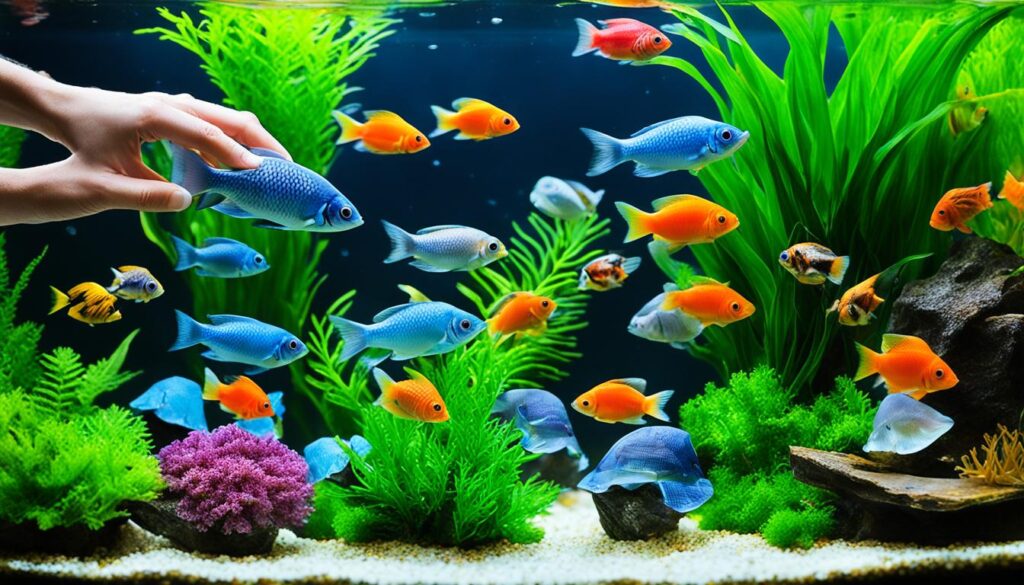
“By providing your snails with a balanced diet and maintaining a suitable water environment, you can promote their overall health and prevent common snail-related issues in your fish tank.”
Create a Suitable Habitat for Snails
Snails, like any other living organisms, require a suitable habitat to thrive in a freshwater aquarium. Providing them with the right conditions will help ensure their health and well-being. Here are some key factors to consider when creating a suitable habitat for snails:
- Proper Substrate: Snails need a suitable substrate to burrow, lay eggs, and forage for food. Choose a substrate that is soft and sandy, as it mimics the natural environment of snails and allows them to move easily. Avoid sharp or coarse substrates that can harm their delicate shells.
- Temperature Regulation: Maintaining a stable temperature is crucial for the overall well-being of snails. Most freshwater snails prefer a temperature range between 72°F and 78°F (22°C and 26°C). It’s important to use a reliable aquarium heater or chiller to ensure the water temperature remains within this range.
- Clean Water: Clean water is essential for the health of snails and the overall balance of the aquarium. Regular water changes and maintenance are necessary to prevent the buildup of harmful substances like ammonia and nitrate. Snails are particularly sensitive to water quality, so monitoring water parameters regularly is important.
- Live Plants: Incorporating live plants into the aquarium not only adds aesthetic value but also provides natural grazing and hiding spaces for snails. Plants like Java Moss, Anubias, and Hornwort are popular choices that can help create a favorable environment for snails.
By providing a proper substrate, regulating the temperature, maintaining clean water, and incorporating live plants, you can create a suitable habitat for snails in your freshwater aquarium. Remember, a well-maintained habitat will promote their health and natural behaviors, contributing to a balanced and thriving ecosystem.
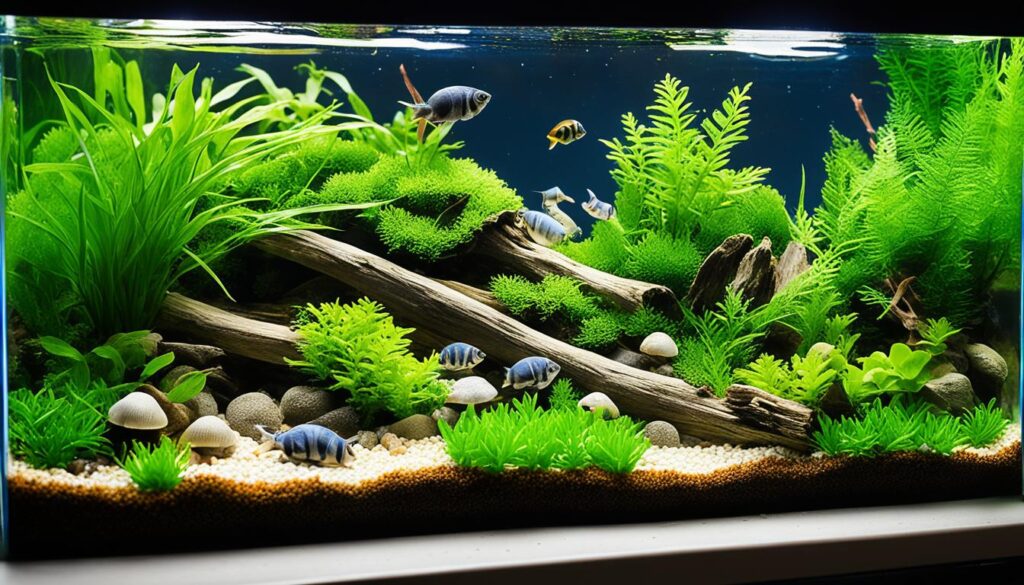
Conclusion
Managing and controlling snail populations in freshwater aquariums can be a challenging task for aquarium enthusiasts like myself. However, by implementing the right methods and practicing perseverance, it is possible to prevent and control snail infestations effectively. Following the tips mentioned above and taking proactive measures can help create and maintain a healthy and balanced ecosystem in your fish tank.
One of the key factors in snail control is ensuring that your tank is not overfed. By feeding your fish in moderation and providing only enough food for them to consume at each feeding, you can reduce the excess food available for snails. This simple practice can go a long way in controlling their numbers.
When it comes to snail control, it’s important to consider the use of chemicals as a last resort. While chemicals can be effective in killing snails, it’s crucial to follow the directions on the bottle carefully to prevent harm to your fish and plants. Additionally, setting up snail traps, introducing snail predators, and implementing multiple solutions can also aid in controlling their population.
Lastly, maintaining a clean tank, inspecting and quarantining new additions, and dipping aquarium items in snail-killing solutions can further prevent snail infestations in your tank. By creating a suitable habitat for snails and providing them with adequate food and water conditions, you can ensure their well-being and the overall health of your aquarium.
In conclusion, with determination and the right techniques at hand, you can successfully manage snail populations in your freshwater aquarium. By implementing these strategies and staying proactive in your approach, you will be able to maintain a balanced and thriving ecosystem in your fish tank.
FAQ
How can I control snail population in my freshwater aquarium?
There are several effective ways to control snail population in your freshwater aquarium. These include avoiding overfeeding, using chemicals as a last resort, setting snail traps, introducing snail predators, trying multiple solutions, cleaning everything, inspecting and quarantining new tank additions, dipping aquarium additions in a snail killing solution, providing adequate food and water conditions for snails, and creating a suitable habitat for them.
How can I avoid overfeeding to control snail population?
Overfeeding your aquarium inhabitants can lead to a boom in snail population. To control snail overpopulation, try underfeeding your fish and only providing enough food for them to eat at each feeding. This will reduce the amount of excess food that snails can feed on and help control their numbers.
Should I use chemicals to control snail population in my aquarium?
Chemicals can be used to kill snails in the aquarium, but they should only be used as a last resort after trying other natural solutions. Copper sulfate is a commonly used fish-safe chemical for killing snails. However, it is important to carefully follow the directions on the bottle to avoid harming your fish and plants. Chemical treatments can cause a massive snail die-off, which may require extra effort to clean up and maintain the water quality in the tank.
How can I set snail traps to catch and remove snails?
Snail traps can be used to catch and remove snails from the aquarium. There are various snail traps available online and in pet stores, but a simple trap can be made by placing a large piece of lettuce in the tank and securing it to the side. Overnight, the snails will gather on the lettuce, allowing you to remove them in the morning. This process can be repeated for multiple nights to help reduce the snail population.
What can I do to introduce snail predators to my tank?
Adding snail predators to your tank can help control the snail population. Scavenger fish like Zebra or Dwarf Chain loaches are good options for smaller tanks, while Clown Loaches or Pictus Catfish can be added to larger tanks. Assassin snails are also effective at controlling snail populations as they eat their snail brethren.
Should I try multiple solutions to control snail population?
Since snails can quickly multiply and overwhelm the tank, it is often necessary to try multiple solutions to control their population. Different methods may work more effectively on different types of snails, so it’s important to be persistent and adaptable in your approach.
What should I do to completely eliminate snails from my tank?
If the snail infestation is severe or you want to completely resolve the issue, a deep clean of the tank may be necessary. This involves removing all items in the tank, including gravel, decor, and plants, and thoroughly cleaning and drying them before refilling and restocking the tank.
How can I prevent snail introduction into my tank?
To prevent the introduction of snails into the tank, it is important to inspect any items before adding them. Live plants and decor should be checked for snails or snail eggs before placing them in the tank. Quarantine tanks can also be used to separate and monitor new additions, allowing any snails or eggs to be removed before they can infest the main aquarium.
How can I dip aquarium additions in a snail killing solution?
Dipping aquarium additions in a snail killing solution can help eliminate snails and their eggs. Bleach solutions or aluminum sulfate can be used to kill snails and their eggs, but caution should be exercised to avoid harming live plants and other aquarium inhabitants. It’s important to thoroughly rinse the treated items before adding them to the tank.
What should I do to provide adequate food and water conditions for snails?
To ensure the health of your snails, it’s important to provide them with adequate food and water conditions. Snails feed on plants, algae, and decaying matter, so it’s important to provide them with a balanced diet and regular feeding. Tap water should be treated or purified to remove any chemicals or contaminants that can harm snails.
How can I create a suitable habitat for snails in my tank?
Snails require a suitable habitat in the tank to thrive. This includes providing them with a proper substrate, maintaining a stable temperature, and keeping the tank clean. Snails also benefit from having live plants in the tank, which provide them with natural grazing and hiding spaces.

